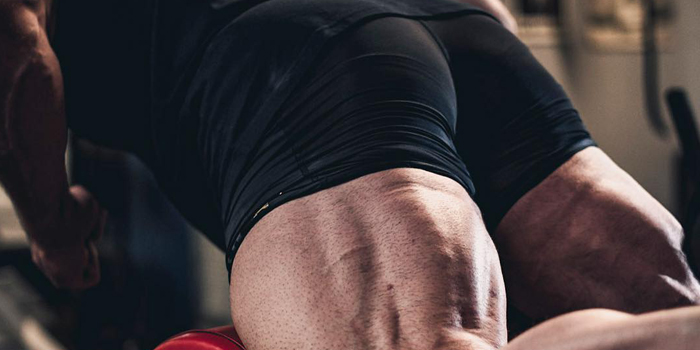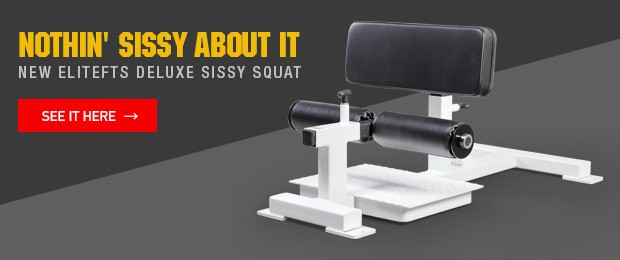
By now, I hope you’re familiar with my Bodybuilding for Powerlifting series, but in case you’re not, here’s the big picture: bodybuilding and powerlifting are complimentary. If you’re not studying and learning from both disciplines, you’re selling yourself short. Bodybuilding can build strength by helping you to better target smaller muscles, to emphasize certain muscles over others in compound movements, and to correct imbalances. But the opposite is true, too: a stronger muscle is generally a bigger muscle, so powerlifting can help up-and-coming bodybuilders establish a strong base on which to build a phenomenal physique.
The list of “powerbuilding” articles from this series has grown pretty extensive over the past year or so, and rather than link to every individual article, I highly encourage you to start here, and then head over to my author page and click on “Articles” if you’d like to read more.
RECENT: Bodybuilding for the Powerlifter: Why and How to Use the Maximal Effort Method
This month, we’re looking at the hamstrings — a muscle group many bodybuilders and strength athletes alike really struggle to develop. Now, if you’re naturally lower-body dominant, like me, maybe you don’t need to spend a whole lot of time bringing your hamstrings up to par. But chances are, you can still benefit from learning to train them more efficiently. And, of course, if you’ve got piglets instead of hammies, I don’t need to convince you to read on.
The Function of the Hamstrings
Unlike some muscles, the hamstrings have two primary functions. They help to bend the leg at the knee — the opposite of the quadriceps — and to extend the hip joint. Now, if you’re a powerlifter, you might not immediately see the full value of a strong pair of hamstrings. After all, you’re trying to extend your knees on the squat and deadlift, not bend them! And yet, the hamstrings are actually quite essential if you want to build maximal, balanced strength in these movements. They:
- Help you to control the descent on your squat
- Function as an antagonist to the quads, helping to keep a proper hip position and torso angle off the floor in the deadlift and out of the hole in the squat
- Protect you from injury by helping to stabilize the knee joint
Now, most bodybuilders know the value of a good pair of hamstrings, because they know that shows are won from the back — and you can have the best set of lats in the world, but if they’re matched with a stringy pair of hamstrings, no judge is going to give you the gold. And every bodybuilder seems to covet that elusive definition where the glutes and hamstrings connect near the hips.
Nevertheless, bodybuilding routines for hamstrings are usually comprised of little other than a relatively light, single-joint movement: the hamstring curl. Sure, maybe some stiff-legged deadlifts are thrown in occasionally, but that’s about the extent of it. SLDL and hamstring curls can be great movements, but unless you’re naturally gifted with good hamstrings, they’re probably not going to be enough on their own, simply because you can’t load the curl heavily enough, and the lower back tends to dominate when heavy loads are used with the SLDL.
This is where powerlifting comes in.
Finding the Right Movements
In my experience, the best hamstrings movements do three things:
- They allow you to use a lot of weight, and to steadily use more weight from training session to training session (i.e., to progress). In other words, movements other than hamstring curls. I’ll get into more details below.
- They put the hamstrings under a loaded stretch. Again, the hamstring curl falls short here: generally, when the leg is fully extended, the hamstring isn’t under any load (although it depends on your exact setup). Stiff legged deadlifts put the hamstrings under a great loaded stretch, as do the other movements listed below.
- They’re ones you can perform safely. So many athletes are plagued by hamstring injuries, or just general tightness in the area, because our daily lives tend to center around extension of the knee (walking up stairs, for example) and positions where the hamstrings don’t get any use (sitting in an office chair). Using too much of a loaded stretch or too fast a progression on movements that you can’t perform safely is a great way to get hurt.
Now, there are actually a lot of movements that fit the bill — but they’re not conventional ones. Let’s look at some of my favorites:
- Banded Stiff-Legged Good Mornings. An often overlooked variation that is incredibly difficult and effective for the hamstrings, and puts a surprisingly little load on the lower back.
- Glute-Ham Raises. A staple in powerlifting training, and for good reason. When done properly, with tight abs and a neutral torso position, this one is incredibly difficult. If you don’t have access to a GHR, you can use the pads of a lat pulldown machine, and a PVC pipe for support.
- Inverse Curls. Inverse curls address all the drawbacks of hamstring curls: the movement is actually hardest when the leg is extended, but because you can use a bit of momentum to power through that range of motion, you can add weight pretty regularly. The big drawback, of course, is that most gyms don’t have an inverse curl machine, and it’s hard to jerry-rig a solution.
- Swiss Ball Glute Bridge. More of a prehab or rehab movement, but effective enough that it made the cut.
As always, how you perform these movements is more important than what particular movement you choose. Let’s look at an example.
The Banded Stiff-Legged Good Morning
Most powerlifters are pretty familiar with good mornings and their benefits. Shoot, the Westside Barbell method uses either the good morning or box squat for the vast majority of lower-body maximal training to help improve the competition squat and deadlift. Lately, especially with the rise of raw powerlifting, good mornings have started to develop a bad rap as a “dangerous” exercise, which I think is ridiculously unfair. However, it’s true (especially if you’re a bodybuilder), the risk of injury on certain movements, including arguably good mornings, outweighs their benefits.
That’s where bands can become really useful. When used correctly, they put the hamstrings under the most stress at the top of the good morning, where the hips are extended, the stretch in the muscle lessened, and therefore the risk of injury somewhat lower.
Of course, the “used correctly” part is key. Here are some things to keep in mind to perform the good morning safely while working the hamstrings as hard as possible:
1. Keep the core braced. This is true for most movements, but especially when you’re potentially putting the lower back under a lot of load. If you have trouble bracing, there are tons of great resources here on elitefts that can help. You can also check out this video:
2. Hinge at the hips. Again, the hip hinge is a foundational movement, but it can be tricky to learn. Once you’ve got a solid brace, push your hips backward while keeping your torso straight and knees slightly unlocked. Read more about the proper performance of a hip hinge here.
3. Keep the legs (almost) straight. By bracing and hinging while not bending the knees, you’re putting the hamstrings under an incredible stretch, and therefore they must work harder to move the weight.
4. Use a steady cadence. Rep cadence is overlooked by powerlifters and bodybuilders alike, but it’s an important part of productive training. If you’re just sort of hanging out between reps, you’re not keeping your hamstrings under constant tension. And if you’re moving too quickly, you’re increasing your risk of injury.
It’s true that if you follow these guidelines, you’ll probably end up using a much lighter weight than if, say, you used a little more lower back or momentum. When it comes to powerlifting, that’s a trade-off you’ll need to consider: sometimes, using more weight is better than using absolutely perfect form. With bodybuilding, that is rarely true. If you want bigger hamstrings, forget your ego, lighten the weight, and tighten up.
Putting it all together should look something like this.
You can then add bands by anchoring one end of each to a heavy dumbbell, and the other to the bar. Make sure the bands hang perfectly straight at the top of the movement.
Sample Deadlift Routine (with Hamstring Focus)
Here’s a sample deadlift routine with a focus on the hamstrings:
- Competition Deadlift: 5x5 with 80% 1RM, followed by one set of max reps with 65% 1RM
- Banded Stiff-Legged Good Mornings: 4 sets of 20, 15, 12, and 8 reps, resting two minutes between sets and adding weight each set. Use the band-and-bar setup described above.
- Weighted Back Extension: 3 sets with a weight you could use for about 15 reps. Perform each set to failure, and focus on keeping a static contraction in the hamstrings and glutes so that only the lower back is involved in the actual movement of your body.
- Abs: 3 sets of resisted leg lowers using a heavy band for max reps.
Wrapping Up
Learning from other strength disciplines is crucial if you want to reach your potential. Just like powerlifters can benefit from bodybuilding movements, bodybuilders can benefit from powerlifting movements — as long as they’re performed correctly. And incorporating heavy, compound lifts allows you to make your training more efficient and more effective.










